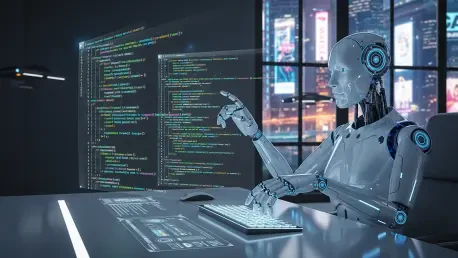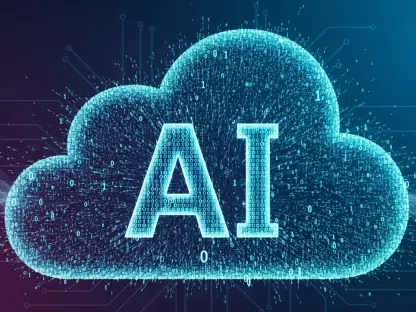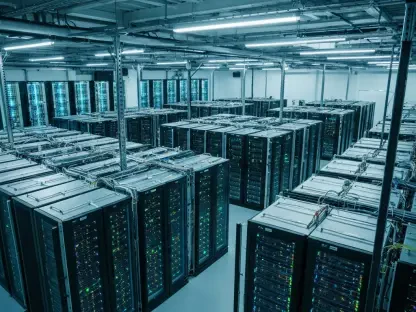In the fast-evolving landscape of software development, artificial intelligence (AI) has emerged as a game-changer, promising to revolutionize how code is created and maintained, with scenarios where a single prompt can generate an entire application in minutes. This unprecedented speed often slashes development timelines dramatically, yet it frequently comes at the expense of quality, leaving developers grappling with buggy, unvetted code that can spiral into costly technical debt. This report delves into the transformative impact of AI on software development, exploring the balance between rapid code generation and the critical need for robust review mechanisms. It aims to unpack the trends, challenges, and future prospects of this technology, shedding light on how the industry can harness its potential while mitigating inherent risks.
Understanding AI in Software Development
AI’s integration into software development has reached a pivotal stage, with adoption rates soaring across enterprises and startups alike. This technology is no longer a novelty but a core component of modern coding practices, driving efficiency by automating repetitive tasks and enabling developers to focus on complex problem-solving. From generating code snippets to suggesting optimizations, AI tools are reshaping workflows and setting new benchmarks for productivity in the tech sector.
A key area of impact lies in AI-driven code generation, supported by major platforms and tools that have gained traction in recent years. Industry players like CodeRabbit stand out by offering solutions that not only create code but also provide critical review capabilities to ensure quality. These tools are becoming indispensable as companies strive to keep pace with accelerating project demands while maintaining high standards in their deliverables.
The significance of AI extends beyond mere automation; it acts as a catalyst for innovation within the tech landscape. By reducing time-to-market for software products, AI empowers organizations to experiment with novel ideas and scale operations swiftly. This transformative potential underscores why AI is viewed as a cornerstone of future development strategies, promising to redefine how technology evolves to meet global demands.
Trends and Growth in AI Code Generation
Key Developments and Innovations
The landscape of AI code generation is marked by rapid advancements, with tools now capable of producing functional code from minimal input, such as a single user prompt. This capability has streamlined development processes, allowing teams to prototype and iterate at an unprecedented pace. Additionally, the rise of specialized AI tools tailored for specific programming languages or frameworks signals a maturing market focused on precision and customization.
Beyond generation, emerging technologies like AI-powered code review systems are gaining prominence as essential components of modern workflows. These systems analyze code for potential flaws, enhancing reliability in an era where speed often trumps thoroughness. Furthermore, the concept of an agentic Software Development Lifecycle (SDLC) is taking shape, where multiple AI agents collaborate to handle distinct phases of development, from creation to testing and deployment.
Market drivers fueling these trends include the relentless demand for faster development cycles and the need for scalability in coding environments. Organizations are increasingly relying on AI to manage sprawling codebases and meet tight deadlines without compromising on output. This convergence of innovation and necessity presents vast opportunities for growth, positioning AI as a linchpin in addressing the complexities of contemporary software demands.
Market Insights and Future Projections
Adoption rates of AI tools in software development continue to climb, with platforms supporting code generation and review witnessing significant user growth over recent years. Industry events like GitHub Universe serve as barometers of this momentum, showcasing how AI integration is becoming a standard rather than an exception. Data indicates that a substantial percentage of developers now rely on these tools to enhance their workflows, reflecting a broader shift toward automation.
Looking ahead, forecasts suggest a deeper integration of AI agents into development processes, with projections estimating a marked increase in their usage from this year to 2027. This trend points to a future where agentic systems could dominate SDLC ecosystems, orchestrating end-to-end project lifecycles with minimal human intervention. Such advancements promise to further elevate productivity, though they also raise questions about oversight and accountability.
Performance metrics highlight AI’s tangible impact on efficiency, with reports showing substantial reductions in coding time across various sectors. However, these gains are tempered by rising concerns over technical debt and quality degradation, as hastily generated code often lacks the robustness required for long-term sustainability. Balancing these dynamics remains a critical focus for stakeholders aiming to leverage AI without incurring hidden costs.
Challenges in AI-Generated Code
The allure of AI code generation is often overshadowed by significant hurdles, chief among them being the speed-quality trade-off. While AI can produce code at remarkable speeds, the output frequently includes what industry experts term “AI slop”—unvetted, error-prone code riddled with redundancies and lacking architectural foresight. This compromises maintainability and poses risks to project timelines when issues surface during later stages.
Technical debt emerges as a pressing concern, as poorly structured AI-generated code accumulates over time, creating scalability bottlenecks. Unlike errors in other AI applications, coding mistakes carry a high cost, potentially leading to security vulnerabilities or system failures that are far more consequential. The stakes are elevated in environments where precision and reliability are non-negotiable, underscoring the urgency for effective mitigation strategies.
Potential solutions lie in the deployment of AI-powered code review tools that act as automated gatekeepers, identifying flaws before they escalate. However, these tools are not a cure-all; human oversight remains indispensable to ensure alignment with project goals and standards. Combining technological safeguards with expert judgment offers a pathway to address quality concerns, fostering a more sustainable approach to leveraging AI in development.
Regulatory and Governance Considerations
Navigating the regulatory landscape for AI in software development presents a complex challenge, as the technology outpaces existing frameworks. There is a growing call for standardized guidelines on code quality and security to prevent systemic risks stemming from flawed outputs. Establishing such norms is vital to ensure that AI-driven innovations do not inadvertently compromise critical systems or user trust.
Compliance issues, particularly around data privacy and security vulnerabilities, add another layer of difficulty. AI-generated code can unintentionally expose sensitive information or introduce exploitable weaknesses if not rigorously vetted. Addressing these risks requires robust protocols to govern how AI tools access and process data, ensuring adherence to global privacy mandates while safeguarding intellectual property.
Governance frameworks are equally critical, providing a structure for balancing innovation with accountability. Intelligent oversight mechanisms, whether through policy or technology, help maintain ethical boundaries in AI deployment. As the industry evolves, collaboration between regulators, developers, and tool providers will be essential to craft adaptive policies that support progress without sacrificing safety or integrity.
The Future of AI in Software Development
Envisioning the trajectory of AI in software development reveals a horizon dominated by fully agentic SDLC ecosystems. These systems, comprising interconnected AI agents, could autonomously manage entire development cycles, from ideation to deployment, minimizing manual intervention. Such a paradigm shift promises to tackle the escalating complexity of modern software projects with unparalleled efficiency.
Disruptors like advanced AI collaboration tools are poised to redefine team dynamics, enabling seamless integration across diverse platforms and workflows. Meanwhile, the role of developers is expected to evolve from hands-on coding to strategic oversight, akin to architects guiding intricate systems. This transition emphasizes the value of technical expertise as a force multiplier in navigating AI-augmented environments.
Global tech trends, including consumer demand for faster, more reliable software solutions, will continue to drive AI augmentation. Innovation in this space is likely to focus on enhancing interoperability among AI systems, ensuring they can adapt to varying organizational needs. As these developments unfold, the industry must remain agile, anticipating shifts in expectations and technology to stay ahead of the curve.
Conclusion and Recommendations
Reflecting on the insights gathered, it becomes evident that AI code generation has reshaped software development by accelerating processes while introducing nuanced challenges in quality and oversight. The exploration of trends and market dynamics revealed a clear trajectory toward automation, tempered by the persistent need for human guidance to navigate pitfalls like technical debt.
Moving forward, actionable steps emerge as crucial for harnessing AI’s potential sustainably. Industry stakeholders are encouraged to invest in robust AI review platforms to bolster code integrity, ensuring that speed does not undermine reliability. Additionally, prioritizing training programs for developers to adapt to oversight roles proves essential, equipping them to steer AI tools effectively.
A collaborative approach between humans and AI stands out as the most promising path, fostering partnerships that balance innovation with accountability. By focusing on governance and skill development, the sector can address emerging risks while capitalizing on AI’s transformative power. These considerations provide a roadmap for navigating the evolving landscape, ensuring that technology serves as an enabler rather than a liability.









